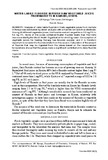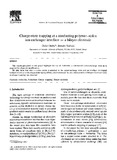Faculty of Science & Technology (FST): Recent submissions
Now showing items 2681-2700 of 4284
-
Infection of Amblyomma variegatum with a hymenopteran parasitoid in the laboratory and some aspects of its basi biology
(University of Nairobi.school of Biological Sciences, 1984) -
Natural and experimental infection of Rhipicephalus appendiculatus with pathogens and their potential for control of ticks
(University of Nairobi.school of Biological Sciences, 1995) -
Water-labile fluoride in fresh raw vegetable juices from markets in Nairobi, Kenya
(Department of Chemisty, University of Nairobi, 2005)Analysis of water-labile fluoride in fresh vegetable juices from markets in Kenya was conducted by direct analysis with a fluoride ion selective electrode. Among 20 different vegetable juices, the fluoride content ranged ... -
Mortality and pathology in tsetse flies (Glossina spp.) treated with Neem extracts
(University of Nairobi.school of Biological Sciences, 1996) -
Factors influencing vector/parasite transmission of Theileriosis in Africa
(University of Nairobi.school of Biological Sciences, 1998) -
Characterization of Amblyomma variegatum tick saliva and salivary gland antigens inducing anti-tick immunity in Boran cattle
(University of Nairobi.school of Biological Sciences, 1998)The sequence of proteins synthesized during the feeding of Amblyomma variegatum and humoral resistance acquired by Boran cattle when exposed to A. variegatum infestations were studied. Resistance was induced by repeatedly ... -
Charge-state trapping at a conducting polymer-redox ion-exchanger interface - a bilayer electrode
(ElsevierDepartment of Chemisty, University of Nairobi, 1996-02)The results presented in this paper highlight the use of Amberlite, a commercial cation-exchange resin as a material for electrode modification. We also show that when a redox centre is attached to the cation-exchange ... -
Fecundity and survival of tsetse maintained on immunized rabbits Kaaya Godwin P.; Alemu Patrick
(1982)Female Glossina morsitans morsitans maintained on rabbits previously immunized with whole tsetse body (WTB), engorged tsetse guts (ETG) or gravid tsetse uteri (GTU) for three successive generations showed no increase in ... -
Subcellular degeneration of mycetomal endocytobionts in tsetse,Glossina morsitans morsitans, inoculated twice withEscherichia coli
(Springer, 1989)Specimens of mycetome, a portion of anterior midgut harboring intracellular bacterioids (endocytobionts), obtained from both untreated control female tsetse,Glossina morsitans morsitans, and those inoculated twice with ... -
Mortalities induced by entomopathogenic fungus Metarhizium anisopliae to different ticks of economic importance using two formulations
(2011)The objective of this study was to compare the infe ctivity of Metarhizium anisopliae at a concentration of 1 × 10 8 conidia/ml to developmental stages of Amblyomma variegatum, Rhipicephalus appendiculatus and ... -
Studies On The Development And Survival Of Rhiphicephalus Pulchellus And Amblyomma Gemma Under Field Condition In Ethiopia
(University of Nairobi.school of Biological Sciences, 2001) -
Prospects for Biological Control of Livestock Ticks,Rhipicephalus appendiculatusandAmblyomma variegatum,Using the Entomogenous FungiBeauveria bassianaandMetarhizium Anisopliae
(Elsevier, 1996-01)Both Beauveria bassiana and Metarhizium anisopliaeinduced approximately 30% mortalities in adultRhipicephalus appendiculatusfeeding on rabbits whileM. anisopliaeinduced a mortality of 37% in adultAmblyomma variegatum.Both ... -
The potential for antitick plants as components of an integrated tick control strategy
(University of Nairobi.school of Biological Sciences, 2004) -
Land-based activities, pollution sources and levels in water and sediment in the coastal and marine area of Kenya
(2006)Kenya has a land area of 580,000 km2 and lies astride the equator. It has a coastline bordering the Indian Ocean, which runs about 600 km long in a south-westerly direction with varying, marine and coastal wetlands rich ... -
Clinico-pathological Aspects Of Trypanosoma Congolense Infection In Goats
(University of NairobiCollege of Humanities and Social Sciences, 1977)Abstract Not Available -
The introduced Micropterus salmoides in an equatorial lake: a paradoxical loser in an invasion meltdown scenario?
(Springer NetherlandsSchool of Biological Sciences, University of NairobiDepartment of Biology, University of Leicester, University Road, Leicester, LE1 7RH, UK, 2010)Micropterus salmoides is a North American piscivorous fish on the IUCN list of 100 of the world’s worst invasive alien species. Introduced into Lake Naivasha (Kenya) in 1929, their current population abundance is significantly ... -
Removal of Cu(II) from Aqueous Solution Using a Micaceous Mineral of Kenyan Origin
(2009)A micaceous mineral (MicaM) available locally in Kenya was utilized as an inexpensive and effective adsorbent for the removal of Cu2+ ions from aqueous solution. The effects of contact time, pH, temperature, adsorbate and ... -
Macrofauna Settlement on Pearl Oyster Collectors in Kenya: Seasonality and Abundance
(Kenya Marine and Fisheries Research InstituteDepartment of Zoology, University of Nairobi, 2008)—Collection of pearl oyster seed using artificial collectors is a critical step in the production of cultured pearls. This paper reports the seasonal abundance of macrofauna, which settled on spat collectors set to ... -
Determination of manganese, iron, copper, zinc, cadmium and lead in fish species, and sediments from Mombasa town and the Winam Gulf of Lake Victoria
(University of Nairobi, 1985)Manganese, iron, copper, zinc, cadmium and lead were determined on 218 fish and 20 sediment samples collected from selected sites in Winam Gulf of Lake Victoria and Mombasa Old Town on the Indian Ocean (Kenya) were analysed ... -
The Distribution of Cu and Pb Levels in Soils and Acacia xanthophloea Benth. from Lake Nakuru National Park Kenya
(Department of Chemistry, University of Nairobi, 2007)Environmental pollution with toxic metals continues to be a serious global concern. Pollution of soils with toxic trace metals have increased considerably since the onset of industrialization and urbanization (Nriagu, 1990; ...





